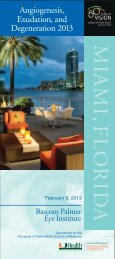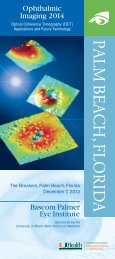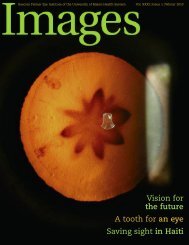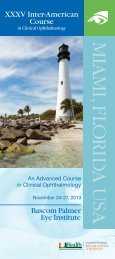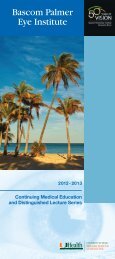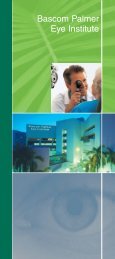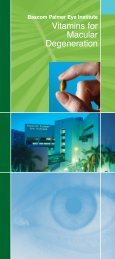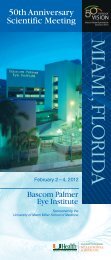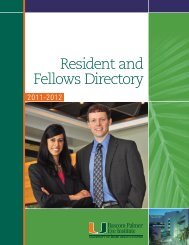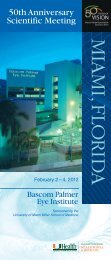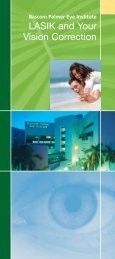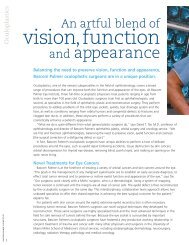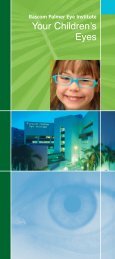Images Magazine Spring 2013 - Bascom Palmer Eye Institute
Images Magazine Spring 2013 - Bascom Palmer Eye Institute
Images Magazine Spring 2013 - Bascom Palmer Eye Institute
- No tags were found...
Create successful ePaper yourself
Turn your PDF publications into a flip-book with our unique Google optimized e-Paper software.
<strong>Images</strong><strong>Bascom</strong> <strong>Palmer</strong> <strong>Eye</strong> <strong>Institute</strong> | University of Miami Health System Volume XXXII | Issue 1 | spring <strong>2013</strong><strong>Bascom</strong> <strong>Palmer</strong> <strong>Eye</strong> <strong>Institute</strong> | University of Miami Health System Volume XXXII | Issue 1 | summer <strong>2013</strong><strong>Bascom</strong> <strong>Bascom</strong> <strong>Palmer</strong> <strong>Palmer</strong> Celebrates Celebrates 50 Years 50 YearsAnd is Once Again RankedBest in #1 in Ophthalmologyfor the 10th Year in a Rowby U.S.News by U.S.News and World & World Report! Report!#1
You have only one pairof eyes. Trust them to thenation’s # 1 eye hospital. *<strong>Bascom</strong> <strong>Palmer</strong><strong>Eye</strong> <strong>Institute</strong>.*U.S.News & World Report1 2For 10 years in a row,<strong>Bascom</strong> <strong>Palmer</strong> <strong>Eye</strong> <strong>Institute</strong>has been rated the nation’sleading center for eye careby U.S.News & World Report.3<strong>Bascom</strong> <strong>Palmer</strong> assistspatients of all ages withevery type of eye conditionat state-of-the-art centersin Miami, Naples, Plantation,and Palm BeachGardens.4“<strong>Bascom</strong> <strong>Palmer</strong> provides unsurpassedexpertise in eye concerns that rangefrom the routine to the rare—and trainsophthalmologists in the very latestapproaches to eye care.” – Eduardo C.Alfonso, M.D., professor and chairmanof <strong>Bascom</strong> <strong>Palmer</strong> <strong>Eye</strong> <strong>Institute</strong>.An outstanding program of UHealth – Universityof Miami Health System, <strong>Bascom</strong> <strong>Palmer</strong><strong>Eye</strong> <strong>Institute</strong> is home to the most sophisticatedexpertise and technologies for diagnosis andtreatment of all types of eye conditions. Serving asthe Department of Ophthalmology for the University'srenowned Leonard M. Miller School of Medicine,<strong>Bascom</strong> <strong>Palmer</strong> is dedicated to developing new waysto protect, preserve, and restore the gift of sight.All <strong>Bascom</strong> <strong>Palmer</strong>faculty members conductinnovative biomedicalresearch that leadsadvances worldwidein the treatmentof blinding eyediseases.5Our physicians workcollaboratively withspecialists in all areasof medicine at UHealthfor a comprehensiveapproach to a patient’scondition.Every<strong>Bascom</strong> <strong>Palmer</strong>physician specializesin at least one areaof ophthalmiccare.To learn more about <strong>Bascom</strong> <strong>Palmer</strong>, call 888-845-0002.bascompalmer.org
contents50 Years of Discovery and Innovation 450th Anniversary Scientific Meeting 22New Ocular Oncology Center 244Center for Dry <strong>Eye</strong>s Established 26New Faculty Appointments 28Expansion throughout South Florida 30Evening of Vision Gala 3422Philanthropic Donors 36<strong>Bascom</strong> <strong>Palmer</strong> Ranked #1 in USA 4536#145<strong>Bascom</strong> <strong>Palmer</strong> <strong>Eye</strong> <strong>Institute</strong>’s mission is to enhance thequality of life by improving sight, preventing blindness, andadvancing ophthalmic knowledge through compassionatepatient care and innovative vision research.Since 1990, <strong>Bascom</strong> <strong>Palmer</strong> <strong>Eye</strong> <strong>Institute</strong> has been ranked#1 or #2 in ophthalmology in the USA. We have earnedthe #1 ranking 12 times.<strong>Images</strong> is produced by <strong>Bascom</strong> <strong>Palmer</strong> <strong>Eye</strong> <strong>Institute</strong> of the University of Miami Miller School of Medicine with the support of the George C. Brosius Endowment Fund. <strong>Images</strong> is published biannually and isavailable free upon request. If you do not wish to receive <strong>Images</strong> in the future, please send your request in writing to the University of Miami Privacy Office, P.O. Box 019132 (M-879), Miami, Florida 33101.Editor Cynthia Birch, Director of Marketing & Communications / Eduardo C. Alfonso, M.D., Kathleen and Stanley J. Glaser Chair in Ophthalmology ; Chairman, <strong>Bascom</strong> <strong>Palmer</strong> <strong>Eye</strong> <strong>Institute</strong> /Stanley H. Arkin, Chairman, Board of Governors, Anne Bates Leach <strong>Eye</strong> Hospital1
1 2 3 4 5 67 8 9 101112 13 14 15 1617 18 19 20 21 2223 24 25 26L E G E N D2728<strong>Bascom</strong> <strong>Palmer</strong> Celebrates 50 YearsAnd is Once Again Ranked#1 in Ophthalmologyfor the 10th Year in a Rowby U.S.News & World Report! !#129 30 31 32 33(From top, left to right) 1 <strong>Bascom</strong> H. <strong>Palmer</strong>, M.D., 2 Richard K. Forster, M.D. 3 John T. Flynn, M.D. 4 Eduardo C. Alfonso, M.D. 5 <strong>Bascom</strong> <strong>Palmer</strong> <strong>Eye</strong><strong>Institute</strong> 6 Carol L. Karp, M.D. 7 Female faculty members from 2002 8 David T. Tse, M.D. 9 Victor T. Curtin, M.D., Eduardo C. Alfonso, M.D., EdwardW.D. Norton, M.D. 10 Harry W. Flynn, M.D. 11 Jianhua (Jay) Wang, M.D., Ph.D., M.S. 12 Janet L. Davis, M.D. 13 Norman Schatz, M.D. 14 Jean-MarieParel, Ph.D., ING ETS-G 15 Vittorio D. Porciatti, D.Sc. 16 <strong>Bascom</strong> <strong>Palmer</strong>’s annual Curso Inter-Americano attracts 500 ophthalmologists from 30 countries.17 Robert Machemer, M.D. 18 Silicon oil droplets on a silicon intraocular lens 19 Wei Li, Ph.D. 20 John G. Clarkson, M.D. 21 William E. Smiddy, M.D.22 Terrence P. O’Brien, M.D. 23 Carmen A. Puliafito, M.D., M.B.A. 24 James Banta, M.D. 25 Edward W.D. Norton, M.D. 26 William W. Culbertson, M.D.27 Richard K. Parrish II, M.D. 28 <strong>Bascom</strong> <strong>Palmer</strong> is ranked #1 <strong>Eye</strong> Hospital by U.S.News & World Report for <strong>2013</strong>-14 29 Edward W.D. Norton, M.D., andVictor T. Curtin, M.D. 30 <strong>Bascom</strong> <strong>Palmer</strong>’s Vision Van 31 Philip J. Rosenfeld, M.D., Ph.D. 32 Hilda Capó, M.D. 33 Steven J. Gedde, M.D, with residentsNow in Print: Fifty Years of Vision<strong>Bascom</strong> <strong>Palmer</strong> <strong>Eye</strong> <strong>Institute</strong> chronicled its 50-year history in a commemorative golden anniversary, hardcover book titled <strong>Bascom</strong><strong>Palmer</strong> <strong>Eye</strong> institute 50 Years of Vision. Fifty years of achievements are built on the vision of ophthalmologist <strong>Bascom</strong> H. <strong>Palmer</strong>,M.D., who arrived in Miami in 1923, but died before his dream of a comprehensive ophthalmic hospital “second to none” couldbe fulfilled. That mission was taken up by our founder and chairman of 33 years, Edward W.D. Norton, M.D. Recognizing thatthe basic ingredient for excellence is people with knowledge, compassion and integrity, “the Chief” urged us to become the bestophthalmologists we could be, and provided the support for research, teaching and clinical care. This book highlights our successesspanning five decades.To order your copy, please call our Development Office at 305-326-6190 or write bascompalmercommunications@med.miami.edu
message from the chairmanDear Friends and Colleagues:Welcome to <strong>Bascom</strong> <strong>Palmer</strong> <strong>Eye</strong> <strong>Institute</strong>’s 50th anniversary issue of <strong>Images</strong>.In this issue, we are happy to share with you highlights of our remarkable50-year history, which was celebrated in February 2012 with an internationalscientific meeting in Coral Gables, Florida, and various anniversary eventsthroughout 2012. This issue introduces you to some of the most significantadvances made at <strong>Bascom</strong> <strong>Palmer</strong> since its founding, as well as including ournewest doctors, global leaders in ophthalmology whom we have been luckyenough to call colleagues and friends for many years.As we continue to expand our faculty and physical locations, we remaincognizant of the giants upon whose shoulders our progress stands, thefounders of the <strong>Institute</strong>, Drs. Edward Norton, Victor Curtin, Don Gass,John Flynn, Lawton Smith, and so many others. Since 1962, <strong>Bascom</strong> <strong>Palmer</strong><strong>Eye</strong> <strong>Institute</strong> has been setting standards in ophthalmology and forging newunderstanding of eye diseases, their treatments and prevention.Three new centers have opened at <strong>Bascom</strong> <strong>Palmer</strong> in recent months. TheOcular Oncology Center combines the expertise of David Tse, M.D., (eyelid and orbital tumors),Carol Karp, M.D., (ocular surface tumors), and, new to our faculty, Bill Harbour, M.D., (intraoculartumors). These three physicians are not only tackling eye cancer, they are collaborating to advanceour knowledge of eye cancers for future generations. Their affiliation with the University of Miami’sSylvester Comprehensive Cancer Center augments their effectiveness in these endeavors.The Ocular Surface Center is dedicated exclusively to patients with severe ocular surface disorders,including thermal and chemical burns, severe dry eye, and Stevens-Johnson Syndrome. Victor Perez,M.D., the cornea specialist who performed the first modified osteo-odonto-keratoprosthesis in theU.S., is leading a team of specialists who offer novel treatments to patients who are often told nothingmore can be done for them.We have also launched the L. Jules and Shirley Arkin Laser Center, featuring the revolutionary newfemtosecond laser cataract and cornea surgery system co-developed by <strong>Bascom</strong> <strong>Palmer</strong> doctors. Thisnew laser allows us to improve outcomes for cataract and cornea surgery patients.From all of us at <strong>Bascom</strong> <strong>Palmer</strong> <strong>Eye</strong> <strong>Institute</strong>, thank you for your continued support, which hashelped us take giants leaps forward in treating, preventing, and understanding blinding eye diseasesand has supported our doctors and scientists as they teach new generations of ophthalmologists toensure continued advances in eye care. We look forward to another stellar 50 years!Sincerely,Eduardo C. Alfonso, M.D.Kathleen and Stanley J. Glaser Chair in OphthalmologyChairman, <strong>Bascom</strong> <strong>Palmer</strong> <strong>Eye</strong> <strong>Institute</strong>3
50 years1923<strong>Bascom</strong> H.<strong>Palmer</strong>, M.D.,arrives inSouth Florida.He is the onlysurgeon in thestate to performcorneal grafts.1949Miami Lighthousefor the BlindAn early supporter of theMiami Lighthouse for the Blind,Dr. <strong>Palmer</strong> hopes to establish aneye institute “second to none”in the nation.1958Edward W.D. Norton, M.D.,is appointed associate professorand “chief” of the division ofophthalmology, Universityof Miami School ofMedicine. The followingyear, he securesapproval to expandto a department ofophthalmology andis appointed its first“chairman.”4
of discovery and innovation<strong>Bascom</strong> <strong>Palmer</strong> <strong>Eye</strong> <strong>Institute</strong> Celebratesits Golden Anniversary<strong>Bascom</strong> <strong>Palmer</strong> <strong>Eye</strong> <strong>Institute</strong>’s story dates back to 1943, inthe midst of World War II, when <strong>Bascom</strong> Headon <strong>Palmer</strong>,M.D., first discussed the feasibility of establishing an eye clinicin Miami dedicated to saving sight and preventing blindness.<strong>Palmer</strong> was the first surgeon in Florida to perform cornealtransplants. Looking to the future with hope, he predictedMiami would eventually be home to an ophthalmology institutein a medical center second to none in the nation.<strong>Palmer</strong>, who passed away in 1954, lived long enough to see theestablishment of the University of Miami School of Medicine in 1952.Certainly, no one at that time would have guessed that his predication wouldcome true within just a few years – thanks to a remarkable physician namedEdward W. D. Norton, M.D.In 1958, Norton, a young assistant professor of ophthalmology at CornellUniversity Medical College, accepted an offer from the new University of MiamiSchool of Medicine to become the chief of the division of ophthalmology. Hisleadership laid the foundation for the department’s rapid growth.1959Victor T.Curtin, M.D.,a vitreoretinalspecialistand ocularpathologist,is recruited as<strong>Bascom</strong> <strong>Palmer</strong>’ssecond facultymember.1960Harry Belafonteis an early and longtimesupporter of<strong>Bascom</strong> <strong>Palmer</strong> <strong>Eye</strong><strong>Institute</strong>. Dr. Nortonoperated on a retinaldetachment inBelafonte’s eyein 1957.1961 FactsNumber of patients13,600Surgical procedures1,3005
Victor T. Curtin, M.D., Eduardo C. Alfonso, M.D., and <strong>Bascom</strong> <strong>Palmer</strong> Founder Edward W.D. Norton, M.D.For Norton, an excellent neuro-ophthalmologist and a master retinal surgeon, the opening in1962 of <strong>Bascom</strong> <strong>Palmer</strong> <strong>Eye</strong> <strong>Institute</strong>, named in honor of Dr. <strong>Bascom</strong> <strong>Palmer</strong>, was the first step inthe long journey to global leadership in ophthalmology. Under Norton’s dynamic 33-year leadership,as well as the subsequent chairmen who followed him, <strong>Bascom</strong> <strong>Palmer</strong> <strong>Eye</strong> <strong>Institute</strong> has becomeone of the world’s foremost academic medical centers for scientific discovery and clinical innovation.The Early YearsOne of the greatest challenges facing the young institute was the recruitment of outstandingfaculty. Norton was determined to attract the finest ophthalmologists in the country. In 1959, VictorT. Curtin, M.D., a vitreoretinal specialist and ocular pathologist, became the first faculty member1962BuildingdedicationOn January 21,university and civicleaders dedicate<strong>Bascom</strong> <strong>Palmer</strong><strong>Eye</strong> <strong>Institute</strong>, a30,000-square-footbuilding with twofaculty members anda total staff of 12.1962Basic research beginsDuco Hamasaki, Ph.D.,becomes the first basicresearcher to join the faculty.1962J. Lawton Smith, M.D.,a neuro-ophthalmologistand extraordinaryeducator becomesthe third facultymember.6
featureto be recruited by Norton. Throughout their long professional relationship, Norton relied on Curtinto handle a variety of administrative projects, while Curtin also saw patients, interviewed residencycandidates, and maintained the department’s high standards.Along with his clinical and teaching responsibilities, Norton began to reach out to localorganizations and potential donors who could provide the needed funds for a stand-alone eyeclinic. He soon established a close relationship with the Miami Lighthouse for the Blind, which setaside $200,000 in 1959 for construction. Norton and Curtin also became friends with leaders of theFlorida Lions Club, which led to the formation of the Florida Lions <strong>Eye</strong> Bank.The <strong>Institute</strong> OpensWith the support of these organizations, as well as private philanthropists, <strong>Bascom</strong> <strong>Palmer</strong> <strong>Eye</strong><strong>Institute</strong> opened its doors on January 21, 1962, as the first center in the southeast United Statesdevoted exclusively to the study and treatment of the eye. The new institute, located where <strong>Bascom</strong><strong>Palmer</strong>’s Evelyn F. and William L. McKnight Vision Research Center now stands, had 26,000 squarefeet of space in its four floors.J. Lawton Smith, M.D., a neuro-ophthalmologist, joined the faculty in 1962, and focusedhis practice on diagnosing neurological disorders. Recognizing the need to improve physicians’understanding of complex symptoms, the following year, he hosted the nation’s first clinicalpostgraduate educational session devoted to neuro-ophthalmology. The annual scientific meetingcaught on at once and continued for more than 15 years. “Unlike most medical conferences wherepresenters give a lecture illustrated with slides, we had actual patients who could be examined byphysicians attending the course,” Smith said in a 2010 interview. “Our patients benefited by beingable to get multiple opinions on their ophthalmic conditions.”J. Donald M. Gass, M.D., became a faculty member in 1963 and began studying diseases ofthe macula. He soon became a pioneer in the emerging field of fluorescein angiography,a technique in which intravenously injected dye allows the blood vessels in the eye to bephotographed in great detail.Known as the “Father of Macular Diseases,” Gass conceptualized the way in which macularholes form, creating the foundation for surgery on a formerly untreatable condition. In his nearly40 years at <strong>Bascom</strong> <strong>Palmer</strong>, Gass revolutionized the diagnosis and treatment of more than a dozen1965Children’s ClinicfoundedJohn T. Flynn, M.D.,establishesthe children’s clinic andcontinues research onretrolental fibroplasia,later known asretinopathy ofprematurity, a majorcause of blindness innewborns.1966J. Donald M. Gass,M.D.,pioneers the use ofintravenous fluoresceinangiography forthe diagnosis ofintraocular disease,including maculardegeneration. He laterdescribes and classifiesmany of the diseases ofthe macula.7
“The VISC was one tool that woulddo three different things. It providedmacular and vitreo-retinal disorders.He also wrote the Gass Atlas ofMacular Diseases, one of the mostthe foundation for doing intraocularimportant ophthalmological texts. Inmicrosurgery while preventing thea fitting tribute to his stellar career,the Association of Cataract and collapse of the eye.”Refractive Surgeons in 1999 namedJean-Marie Parel, Ph.D., Ing., ETS-GGass as one of the 10 most influentialophthalmologists of the 20th century.After joining <strong>Bascom</strong> <strong>Palmer</strong> in1965, John T. Flynn, M.D., saw many pediatric patients and launched a treatment program foramblyopia (“lazy eye”). Flynn also began looking at retinopathy of prematurity (ROP), known in the1960s as retrolental fibroplasia, a condition that causes abnormal development of blood vesselsin the retina of a premature infant. The result can be scarring and retinal detachment, leading toblindness in serious cases.Using techniques like fluorescein angiography and medical photography of the fundus, Flynndeveloped a five-stage classification for ROP. “Today, every ROP paper uses those internationalclassifications,” said Flynn. “It’s provided the framework for worldwide research on ROP.”Also in the early 1960s, Norton launched the <strong>Institute</strong>’s laboratory research program, whichhas made numerous contributions to the science of vision through the decades. One of his firsthires, Duco I. Hamasaki, Ph.D., focused on neurophysiology, using experimental models to studythe eye’s photoreceptors and gaining insights into the workings of the retina. As Hamasaki said,“I came to <strong>Bascom</strong> <strong>Palmer</strong> because Dr. Norton had a strong commitment to research, as well asteaching and patient care.”Creating a Modern Ophthalmic HospitalOn April 20, 1970, <strong>Bascom</strong> <strong>Palmer</strong> retinal specialist Robert Machemer, M.D., performed theworld’s first pars plana vitrectomy on a Miami patient who had not seen with his right eye for fiveyears. Until then, ophthalmologists had considered the vitreous body forbidden territory becauseof the risk of causing a retinal detachment. This breakthrough was a decade-long team effort81970RevolutionizesvitreoretinalsurgeryRobert Machemer,M.D., performsthe world’s firstsuccessfulpars planavitrectomy.1971 FactsNumber of patients32,000Surgical procedures2,0001970Biophysics Center establishedCredited with developing more than 350 ophthalmicdevices and instruments, Jean-Marie Parel, Ph.D., INGETS-G, creates <strong>Bascom</strong> <strong>Palmer</strong>’s ophthalmic biophysics center.
featureinvolving <strong>Bascom</strong> <strong>Palmer</strong>’sclinicians, researchers,biomedical engineers andvoluntary faculty.This successful procedureopened the door to manynew types of treatments forretinal tears, detachments andscar tissue, as well as macularholes, vitreous hemorrhage,traumatic injuries and otherconditions. “For a youngresearcher, <strong>Bascom</strong> <strong>Palmer</strong>offered an ideal environment,where credit was given to any individual who made a discovery,” said Machemer in a 2007 interview.“It was in this supportive environment that the new art of vitreous surgery evolved.”Back in 1969, Machemer met Jean-Marie Parel, Ph.D., Ing., ETS-G, a Swiss-born biomedicalengineer who was developing motorized microsurgical instruments, in Melbourne, Australia. Theyconceived the idea for an instrument (later called the Vitreous Infusion Suction Cutter or VISC)that could be introduced through the pars plana in order to aspirate, cut and remove the diseasedvitreous while maintaining the shape of the eye through the continuous infusion of saline solution.“It was one tool that would do three different things, “said Parel, who joined the <strong>Institute</strong> in1970. “It provided the foundation for doing intraocular microsurgery while preventing the collapseof the eye.” Most importantly, the early prototype VISC made Machemer’s surgery a success. “Iused that little instrument and it worked,” Machemer said. “The patient, who could only see handmovements, saw 20/40 after the operation.”Two decades later, retinal specialist William E. Smiddy, M.D., contributed to the developmentof vitrectomy for the treatment of macular holes which occur in the central part of the retina. Todayvitrectomy enables surgeons to close about 90 percent of macular holes, a condition previouslythought untreatable.1972Gold Medal findingsDouglas R. Anderson, M.D.,and Ralph Kirsch, M.D.,collaborate to study theoptic nerves of patientswith or without glaucoma.The doctors win a goldmedal for a presentationof their findings at theAmerican Academy ofOphthalmology.1974Richard K. Forster, M.D.,pioneers the use of intraocularantibiotics for endophthalmitis.1976Donor recognitionAnne Bates Leach proudly displaysa rendering of the new hospitalnamed in her honor. Leach donates$4.5 million to the eye hospital thatbears her name.9
U.S. retina specialists now collectively perform an estimated 170,000 vitrectomies each year, withperhaps three times as many being done in the rest of the world – all thanks to this <strong>Bascom</strong> <strong>Palmer</strong>innovation.Through the decades, Parel and his team have invented or improved more than 350 devices,including the world’s smallest motorized scissors, which were used to cut retinal membranes thatobscure vision. At one point, Parel alone had more patents than the entire medical school facultycombined. “Dr. Norton had a view of the future so far reaching it was unbelievable,” said Parel.“He recognized how biophysical engineering could make a huge difference in ophthalmology.”Meanwhile, clinicians and scientists in <strong>Bascom</strong> <strong>Palmer</strong>’s research laboratories were studyingglaucoma and a wide range of othervision-impairing conditions.In the 1970s, Douglas R. Anderson,M.D., was the first to demonstrate anabnormal physiologic process in the opticnerve of glaucoma patients. “We hadknown that pressure damaged the nerve,-Harry W. Flynn, Jr., M.D. but were not sure if it was due to theblood flow or something else,” he said.“We demonstrated a blockage of fastaxonal transport – a vital process to the neurons. We found that elevation of pressure affected thatnerve, and demonstrated that this was secondary, at least in part, to a deficiency in the blood flow.”In 1973, Robert W. Knighton, Ph.D., joined the research faculty, and began studying howto improve clinical imaging of the tissues of the eye. Knighton was in charge of the clinicalelectrophysiology research program, exploring a technology then in its infancy. He looked for new waysto improve electroretinograms that provided clearer diagnostic images to ophthalmic surgeons.“The driving force behind the <strong>Bascom</strong><strong>Palmer</strong> <strong>Eye</strong> <strong>Institute</strong> is the high quality ofthe residents and fellows.”Laser Research BeginsOphthalmologists began experimenting with lasers in the late 1960s and early 1970s forphotocoagulation treatments, using first ruby-red light and later argon blue-green lasers to heattiny spots on the retina. In 1978, <strong>Bascom</strong> <strong>Palmer</strong>’s ophthalmic biophysics center added a laser101978Service to veteransGuy O’Grady, M.D., ran theophthalmology programat the Miami Veteran’sAdministration Hospital formore than 30 years. <strong>Bascom</strong><strong>Palmer</strong> continues to serveAmerica’s veterans.1981 FactsNumber of patients56,000Surgical procedures5,1001979Curso launchedEnglish-Spanish translation is provided at<strong>Bascom</strong> <strong>Palmer</strong>’s popular Inter-AmericanCourse in Clinical Ophthalmology, “CursoInteramericano,” attended each year byhundreds of ophthalmologists from LatinAmerica and the Caribbean.
featureresearch laboratory led by Parel and Hanspeter Loertscher, the Swiss scientist who developed theinfrared YAG laser earlier in the decade. Glaucoma specialist Richard K. Parrish II, M.D., andcornea specialist Sidney H. Mandelbaum, M.D., clinically led the lab, which is credited for thedevelopment of a non-contact laser trephination technique for corneal transplantation.A New HospitalIn the early 1970s, <strong>Bascom</strong> <strong>Palmer</strong>’s growing reputation in the community led to a steadyincrease in patient visits and surgery. Norton recognized a need for an eye hospital complete withexamination rooms and surgical suites. He again placed a highpriority on fund-raising and reached out to several <strong>Bascom</strong><strong>Palmer</strong> patients. One of them was Anne Bates Leach, a residentof Palm Beach whose family had large holdings in the Coca-ColaCompany. Leach contributed major funds for the constructionof a new seven-story, 220,000-square foot eye hospital on a1.5-acre site across the street from the original building, thatwas named in her honor. <strong>Bascom</strong> <strong>Palmer</strong>’s original building wasrenamed the William L. McKnight Research Center. McKnight,retired chairman of the 3M Company and a grateful patient, haddonated $2.5-million for vision research.A retina specialist whose research has ranged from retinal veinocclusion to the ocular manifestations of sickle-cell disease isJohn G. Clarkson, M.D., who joined the faculty in 1977. Morethan a decade later, Clarkson would become chairman of <strong>Bascom</strong> <strong>Palmer</strong> <strong>Eye</strong> <strong>Institute</strong>, and thendean of the University of Miami School of Medicine. He now serves as the executive director of theAmerican Board of Ophthalmology and maintains his position as a <strong>Bascom</strong> <strong>Palmer</strong> faculty member.Another vitreoretinal specialist, Harry W. Flynn, Jr., M.D., joined the faculty in 1978 beginning anextensive career whose specialites include diabetic retinopathy, macular diseases and endophthalmitis.With the opening of the new hospital in 1976 and throughout the decade, <strong>Bascom</strong> <strong>Palmer</strong>’sresidency and fellowship programs attracted a growing number of physicians who wanted to learnfrom some of the top minds in the field. Flynn adds, “The driving force behind the <strong>Bascom</strong> <strong>Palmer</strong>1984GoodHousekeepingSeal ofApproval<strong>Bascom</strong> <strong>Palmer</strong><strong>Eye</strong> <strong>Institute</strong> isnamed the #1 eyehospital in thecountry by U.S.ophthalmologists.1986Preventing scar tissueRichard K. Parrish II, M.D., introduces the drug5-Fluorouracil (5-FU) to prevent the growth ofscar tissue following glaucoma filtering surgery.1986Attacking cancerDavid T. Tse, M.D.,introduces the use ofintra-arterial chemotherapyto treat lethal lacrimalgland cancer.11
<strong>Eye</strong> <strong>Institute</strong> is the high quality of the residents and fellows. They are the true engine of <strong>Bascom</strong><strong>Palmer</strong> <strong>Eye</strong> <strong>Institute</strong>.”New DiscoveriesThe 1980s was a decade of continued growth in clinical services and education programs, with anemphasis on basic scientific research in several new areas. The arrival of laser surgery opened the doorto more effective vision correction and many other types of treatment. <strong>Bascom</strong> <strong>Palmer</strong>’s reputation forhigh quality clinical care continued to grow and, for the first time, the <strong>Institute</strong> was ranked the #1 eyehospital in the United States in a 1984 survey of ophthalmologists by Good Housekeeping.1989Target pressurePaul F. Palmberg, M.D., Ph.D., coins theterm “target pressure” in the AmericanAcademy of Ophthalmology’s guide toglaucoma treatment.1991John G. Clarkson, M.D.,Norton stepsdown as chairmanafter 33 yearsat the helm andClarkson is namedas the secondchairman of<strong>Bascom</strong> <strong>Palmer</strong><strong>Eye</strong> <strong>Institute</strong>.1991Macular holesurgeryWilliam Smiddy,M.D., <strong>Bascom</strong><strong>Palmer</strong> vitreoretinalspecialist,is among the firstphysicians toperform surgeryto close amacular hole.12
In 1982, <strong>Bascom</strong> <strong>Palmer</strong>’s clinicians performedapproximately 4,000 laser procedures.featureAt this time, <strong>Bascom</strong> <strong>Palmer</strong>’s researchers were studying how to use lasers to cut corneal tissue,treat diseased tissue inside the eye and prevent the growth of abnormal scar tissue or tumor cellsinside the eye. Meanwhile, <strong>Bascom</strong> <strong>Palmer</strong>’s clinicians were quick to put this advanced technology toclinical use. In 1982, they performed approximately 4,000 laser procedures. Ophthalmologists beganusing the excimer laser to reshape the cornea in a procedure known as photorefractive keratectomy.Lasers helped <strong>Bascom</strong> <strong>Palmer</strong>’s physicians treat many other types of vision problems. By theearly 1990s, the U.S. Food and Drug Administration (FDA) had approved clinical trials with lasersfor correcting nearsightedness, farsightedness and astigmatism. FDA approval for LASIK and otherrefractive surgeries came in 1995.In 1988, Clarkson directed a multicenter central vein occlusion study, examining a retinal disorderthat causes bleeding from retinal blood vessels. Funded by the National <strong>Eye</strong> <strong>Institute</strong> (NEI), the studylooked at whether early photocoagulation (laser) therapy was the best treatment to prevent furthercomplications and loss of vision.Meanwhile, Knighton was conducting laboratory research on the retinal nerve fiber layer, whichis damaged by glaucoma at an early stage well before the loss of visual sensitivity. His work led theway to better explanations of why some nerve bundles worked better than others. “There is a hugebenefit to being a researcher in a clinical department,” said Knighton. “You can interact with thephysicians and learn what would be most useful to them. Later on, you can see the results of yourlaboratory work being put into practice in the patients’ eye clinics.”After joining the faculty in 1986, Eduardo C. Alfonso, M.D., focused his research and clinicalactivities on corneal transplants, infections of the cornea and ocular pathology. Alfonso became medicaldirector of the ocular microbiology laboratory and began studying artificial corneas, which could beused for patients awaiting transplants in developing nations where donor tissue is often scarce.Advances in <strong>Eye</strong> CareSoon after David T. Tse, M.D., joined the <strong>Bascom</strong> <strong>Palmer</strong> faculty in 1986, he was faced with anextremely challenging case. A 21-year-old patient was facing a deadly cancerous tumor in the tearproducinglacrimal gland that extended all the way into his brain. “Based on actuarial data at thattime, 80 percent of all patients with this lethal orbital tumor would die within ten years,” said Tse.“We decided to try something new in order save this young man’s life.”1991 FactsNumber of patients103,6200Surgical procedures8,3691993William W.Culbertson,M.D.,identifies theherpes virus asa cause of acuteretinal necrosis,a devastatinginfection of theretina.1993Janet Davis, M.D., M.A.leads the fight to savevision in AIDS-relatedeye disease.13
In 1988, Paul F. Palmberg,M.D., Ph.D., helped writeTse had developed a different approach to deliverthe American Academy ofhigh concentrations of chemotherapy directly to theOphthalmology’s guide to tumor, shrinking it prior to surgery. “This protocol hasproduced a survival rate of more than 80 percent, aglaucoma treatment and dramatic improvement over surgery alone,” said Tse.Within a year, the patient’s adenoid cystic carcinomacoined the term “targetwas gone, and 25 years later, he is still alive.pressure” to represent theIn the early 1980s, Parel began studying thebiochemistry of the eye in hopes of finding a bettergoal in halting or slowing approach to cases of advanced diabetic retinopathy,a condition that occurs when a retinal membraneglaucoma damage.grows back after surgical removal. Partnering withParrish, Parel began developing a system to insert acontrolled-release drug that inhibits cellular growthcalled 5-fluorouracil (5-FU) into the eye. Using theOBC’s resources, Parel created tiny implants made from biodegradable synthetic polymers that releaseddrugs at a constant rate for several days, weeks or months, depending on the desired outcome. Thisdrug-delivery system also held the promise of more effective treatments for some glaucoma patients.Parrish began using 5-FU for glaucoma surgery in some patients with improved results. Healso became involved in tissue culture studies that led to a randomized clinical trial funded by theNational <strong>Eye</strong> <strong>Institute</strong> called the Fluorouracil Filtering Surgery Study. The study demonstrated thatusing 5-FU resulted in substantially higher success rates in terms of controlling intraocular pressure.“Dr. Norton gave me the time to do the research,” Parrish said. “That gave me the tremendoussatisfaction of contributing to the advancement of glaucoma surgery.”After joining the faculty in 1980, glaucoma specialist Paul F. Palmberg, M.D., Ph.D., found thatcareful scanning of photographs would allow physicians to detect early signs of retinopathy causedby diabetes more effectively than with a traditional clinical examination. He also discovered that insome patients color photographs could replace a more invasive diagnostic technique that requiredinjecting a dye into the veins. The findings convinced the National <strong>Institute</strong>s of Health to launch the1994<strong>Bascom</strong> <strong>Palmer</strong>named #1 in USAFor the first time, <strong>Bascom</strong><strong>Palmer</strong> is named Bestin Ophthalmology byU.S.News & World Report,a recognition that would berepeated in 1994, 1998, 2004,2005, 2006, 2007, 2008, 2009,2010, 2011 and 2012.1994Richard K. Parrish II, M.D.,becomes <strong>Bascom</strong> <strong>Palmer</strong>’sthird chairman when Clarksonbecomes dean of the Universityof Miami School of Medicine.Parrish edits the <strong>Bascom</strong><strong>Palmer</strong> <strong>Eye</strong> <strong>Institute</strong> Atlasof Ophthalmology, hailedas “an outstandingcontribution toclinical eye care.”14
featureDiabetes Control and Complications Clinical Trial. Palmberg served for a decade on the monitoringcommittee for the trial, which found that tightly controlling blood sugar – guided by frequent homemonitoring by patients with diabetes – significantly lowered the risk of retinal and kidney damage.Later in the decade, Palmberg helped to clarify the relationship between the level of pressurein the eye and how well a glaucoma patient retains peripheral vision. In 1988, he helped writethe American Academy of Ophthalmology’s guide to glaucoma treatment and coined the term“target pressure” to represent the goal in halting or slowing glaucoma damage.Also in the 1980s, vitreoretinal specialist Janet L. Davis, M.D., M.A., focused on the treatmentand disease mechanisms of ocular inflammations and infections. She quickly became a leader in thefight to save sight in AIDS-related eye disease.After years of studying various aspects of the retina, William W. Culbertson, M.D., made akey discovery in 1993. He identified the herpes virus as a cause of acute retinal necrosis (ARN),a devastating infection that can affect the retina, vitreous and lead to optic neuropathy. Hisgroundbreaking discovery helped advance eye treatment for patients with ARN, including manyindividuals whose immune systems had been compromised by HIV/AIDS.Changing With the TimesFollowing Norton’s 1991 retirement, <strong>Bascom</strong> <strong>Palmer</strong> <strong>Eye</strong> <strong>Institute</strong> was led by three chairmen inthe 1990s: John G. Clarkson, M.D., (1991-1996), Richard K. Parrish II, M.D., (1996-1999) andRichard K. Forster, M.D., (interim chair 1999-2001). All three made contributions to the <strong>Institute</strong>’sresearch program while conducting their own clinical studies. “All of us were hired by Dr. Norton,who charged us with being the best ophthalmologists we could be,” said Clarkson, who led aninitiative to expand the institute’s reach beyond Miami by purchasing land in Palm Beach Gardensand opening <strong>Bascom</strong> <strong>Palmer</strong> <strong>Eye</strong> <strong>Institute</strong> at Palm Beach. “Today, our <strong>Institute</strong>’s atmosphereencourages exploration and innovation in ways that improve the patient’s welfare.”On being named chair, Parrish said, “How can we be even better stewards for our patients andstudents? We must make decisions in the best interest of our patients and acquire new medicalknowledge for society at large.” He was the editor for the <strong>Bascom</strong> <strong>Palmer</strong> <strong>Eye</strong> <strong>Institute</strong> Atlas ofOphthalmology, a collaborative effort of the entire faculty published in 2000.1999Richard K. Forster,M.D.,known forhis expertiseon ocularinfectionsand externaldiseases, isnamed interimchairman ofthe <strong>Institute</strong>.1999Carol L.Karp, M.D.,pioneers the useof interferonfor treatment ofocular surfacesquamousneoplasia.2001Carmen A. Puliafito, M.D., M.B.A.,is appointed as chairman. A vitreoretinalspecialist, he isan expert inthe clinicalapplicationof lasers inophthalmology.15
In 2002, the <strong>Institute</strong> treated more than180,000 patients and performed morethan 8,000 surgical procedures.Through the decades, Forster focused his clinical and research work on the cornea and externaleye diseases caused by fungi, bacteria, viruses and toxins. “I developed a unique practice thatencompassed cataract and corneal surgery as well as clinical patient care and research in ocularmicrobiology and inflammatory diseases,” he said.In the oculoplastics service, Thomas E. Johnson, M.D., helped advance a surgical procedurecalled optic nerve sheath fenestration, which relieves built-up pressure around the optic nerve thatcan lead to permanent vision loss and blindness. The results are immediate, often restoring most ofthe vision that was lost, and halting further vision loss.Cornea and external disease specialist, Carol L. Karp, M.D., pioneered a medical treatment forocular surface squamous neoplasia – cancers that grow on the surface of the eye. While studyingthe effectiveness of interferon on other diseases, Karp became interested in the drug’s anti-viral andanti-neoplastic properties. She designed a protocol to study the drug in patients with ocular surfacetumors, curing them of their cancer without surgery. “The results were dramatic from the very firstpatient,” said Karp, whose research has produced several landmark articles on the topic.<strong>Bascom</strong> <strong>Palmer</strong>’s glaucoma researchers took part in the nationwide Advanced GlaucomaIntervention Study, which examined outcomes of laser and surgical glaucoma treatment.When he was applying for a glaucoma fellowship at the <strong>Institute</strong>, Steven J. Gedde, M.D.,saw that <strong>Bascom</strong> <strong>Palmer</strong> had the best reputation in the country for glaucoma fellowship training.Following his training, Gedde joined the faculty, and today serves as program director of <strong>Bascom</strong><strong>Palmer</strong>’s residency program – now ranked as the best training program in the country.Achieving Global LeadershipPhilip J. Rosenfeld, M.D., Ph.D., had spent two decades seeking more effective treatmentsfor the “wet” form of age-related macular degeneration (AMD). When he began studying thisdisorder at <strong>Bascom</strong> <strong>Palmer</strong> in the 1990s, treatment involved thermal laser photocoagulation andphotodynamic therapy to destroy abnormal blood vessels; however, he felt there had to be abetter approach.2004Visionresearchcore grant<strong>Bascom</strong> <strong>Palmer</strong>wins a core grantfor vision researchfrom the National<strong>Eye</strong> <strong>Institute</strong>of the National<strong>Institute</strong> of Health.2004Florida expansionResidents in Naples andPlantation get access to<strong>Bascom</strong> <strong>Palmer</strong> as officesopen under the medicaldirection of Stephen G.Schwartz, M.D., M.B.A.,and Kendall E. Donaldson,M.D., M.S..2005 FactsNumber of patients206,811Surgical procedures10.35216
featureHilda Capó, M.D.In early 2005, Rosenfeld conducted aclinical study of Avastin, a drug thathad been approved for use in treatingcolon cancer. Drawing on his medicalinsights, Rosenfeld felt Avastin could alsobe effective in repairing damaged bloodvessels in the retina.“Not only did Avastin halt the progression of wet AMD in his patients, many even regained visionjust a few days or weeks after treatment.,” said Carmen A. Puliafito, M.D., M.B.A., <strong>Bascom</strong> <strong>Palmer</strong>chairman from 2001 to 2007.Ophthalmologists around the globe quickly put Rosenfeld’s findings into practice and lauded himfor his contributions. “I am honored to receive recognition, but what is even more important is thatpatients all over the world can now see because of these drugs, “said Rosenfeld.As the <strong>Institute</strong>’s reputation continued to grow, patient volume continued to climb. In 2002, the<strong>Institute</strong> treated more than 180,000 patients and performed more than 8,000 surgical procedures.Making Patient Care a Priority<strong>Bascom</strong> <strong>Palmer</strong>’s pediatric service treats approximately 7,000 children annually in its William andNorma Horvitz Children’s Clinic. The outpatient clinic is designed to meet the unique ophthalmicand social needs of children with visual deficiencies including strabismus, amboyopia, retinophathyof prematurity, pediatric glaucoma, retinoblastoma, and rare genetic disorders. Joining HildaCapó, M.D., in <strong>Bascom</strong> <strong>Palmer</strong>’s pediatric service in 2002 was Craig A. McKeown, M.D. <strong>Bascom</strong><strong>Palmer</strong>’s comprehensive approach to pediatric eye care – an approach that combines examination,diagnosis, treatment and education, as well as access to other specialists – is a major advantage intreatment outcomes.Sonia H. Yoo, M.D., joined the corneal and refractive surgery service, and with Culdertson,has investigated the use of lasers to remove cataracts. “As cataract surgery evolves as significanttechnology, femtosecond laser-assisted cataract surgery is now providing greater precision comparedwith manual techniques and may be better for patients overall,” said Culbertson, who has been atthe forefront of vision correction surgery since its earliest days.2005New treatment for maculardegeneration discoveredPhilip J. Rosenfeld, M.D., Ph.D.,introduces use of bevacizumab(Avastin) for the treatment ofretinal diseases including usage forage-related macular degeneration,diabetic retinopathy and othervenous occlusive disease.2005Vision Van travels for HurricaneKatrina care<strong>Bascom</strong> <strong>Palmer</strong> sends three medical reliefteams on its Vision Van to Louisianaand Mississippi, offering free eye care tovictims of Hurricane Katrina.17
Philip J. Rosenfeld, M.D., Ph.D.In the neuro-ophthalmology service, Byron L. Lam, M.D., has studiedretinal degeneration and hereditary eye diseases in order to learn moreabout unexplained visual loss. “Neuro-ophthalmologists have learnednot to take anything for granted in the diagnosis process,” saidLam, founding director of <strong>Bascom</strong> <strong>Palmer</strong>’s Center for Hereditary <strong>Eye</strong>Dseases.In 2006, Alfonso documented an increase in the incidence of anagressive form of fungal corneal infection that was related to softcontact lens use. Working with the U.S. Centers for Disease Control,his findings drew extensive media attention throughout the world andsignificantly reduced the number of new infections.One of Puliafito’s priorities was expanding <strong>Bascom</strong> <strong>Palmer</strong>’s geographic reach in the SouthFlorida region. In 2004, <strong>Bascom</strong> <strong>Palmer</strong> opened patient care centers in Naples (Collier County) withStephen G. Schwartz, M.D., M.B.A., and Kendall E. Donaldson, M.D., M.S., joining the Insituteas medical directors of the centers, respectively, and faculty members in many specialties were hiredfor these facilities.In 2006, a permanent <strong>Bascom</strong> <strong>Palmer</strong> campus was developed in Palm Beach Gardens on landthat the Insitute had purchased in 1994. The 7.4 acre campus opened with a faculty that nowincludes glaucoma specialist, David S. Greenfield, M.D., and cornea and refractive specialistTerrence P. O’Brien, M.D..Not only did <strong>Bascom</strong> <strong>Palmer</strong>’s growth occur in the patient care venue, but dramatic expansionwas also taking place in its laboratories. New faculty members were hired and the Evelyn F. andWilliam L. McKnight Vision Research Center was remodeled to support their research activities.One new scientist was Valery I. Shestopalov, Ph.D., a molecular cell biologist whose researchfocuses on cataract lens development and bioinformatics as applied to glaucoma. He was one of 57U.S. researchers honored by President George W. Bush in 2004 with the Presidential Early CareerAwards for Scientists and Engineers.In 2008, Vittorio Porciatti, D.Sc., became vice chair and director of research at <strong>Bascom</strong><strong>Palmer</strong>. A neuroscientist, electrophysiologist and biophysicist, his research focuses on preventionof glaucoma. “In research, <strong>Bascom</strong> <strong>Palmer</strong> <strong>Eye</strong> <strong>Institute</strong> has grown from half a dozen scientific2006Ribbon cuttingFlorida Governor-elect Charlie Crist, Universityof Miami President Donna Shalala, PascalGoldschmidt, M.D., dean of the University ofMiami Miller School of Medicine, and Puliafitocut the ribbon to dedicate <strong>Bascom</strong> <strong>Palmer</strong> <strong>Eye</strong><strong>Institute</strong> at Palm Beach Gardens.2006Community serviceGlaucoma specialist, Richard K. Lee,M.D., Ph.D., heads <strong>Bascom</strong> <strong>Palmer</strong>’svibrant community serviceprogram whichincludes visionscreenings forthe underserved.2007Vittorio Porciatti, D.Sc.,Neuroscientist, electrophysiologistand biophysicist, is named vicechair and director of research.18
featureresearchers to more than 25 research faculty members, and we are one of the top tenophthalmology labs in the country,” he said at the time. “My vision is for us to continue movingup in the national research rankings as we contribute to a better understanding of ophthalmicdiseases and disorders and the ways to treat and cure them.”Looking Toward the FutureToday, <strong>Bascom</strong> <strong>Palmer</strong>’s tradition of innovation is as strong as ever. From genetic therapy andstem cell treatments to new oncology surgical procedures, the <strong>Institute</strong>’s researchers continueto break new ground. “Working collaboratively with our colleagues at the University of Miami,<strong>Bascom</strong> <strong>Palmer</strong> now has the most robust genetics research program in the nation,” added Alfonso.“That talent has already enabled us to identify specific genes involved in glaucoma and retinaldegenerative diseases.”One of the world’s leading experts in the field of neuro-ophthalmology, John R. Guy, M.D.,is using a five-year $4.7 million NEI grant to study Leber hereditary optic neuropathy (LHON), aninherited genetic defect that affects the eye’s retinal ganglion cells, leading to a progressive lossof central vision. Guy has pioneered gene therapy techniques in the laboratory that will be used totreat people with visual loss from LHON.Unable to see for nine years, Sharron “Kay” Thornton regained her sight in 2009 thanks to asurgical procedure that was performed for the firsttime in the United States at <strong>Bascom</strong> <strong>Palmer</strong>. Thecomplex series of procedures – called modifiedosteo-odonto-keratoprosthesis (MOOKP) – involvedimplanting Thornton’s canine tooth or “eyetooth”into her eye as a base for a prosthetic lens.Corneal specialist Victor Perez, M.D., led amultidisciplinary team that carried out the MOOKPprocess, which was originally developed in Italymore than 50 years before. In MOOKP, the patient’stooth and surrounding bone are carefully removedfrom the mouth. An optical lens is inserted into the“Working collaboratively with ourcolleagues at the University of Miami,<strong>Bascom</strong> <strong>Palmer</strong> now has the most robustgenetics research program in the nation.”Eduardo C. Alfonso, M.D.2007Eduardo C. Alfonso, M.D.,is named <strong>Bascom</strong> <strong>Palmer</strong>’sinterim chairman whenPuliafito becomes dean ofKeck School of Medicineat the University ofSouthern California.Alfonso becomeschairman in 2009.2009<strong>Eye</strong>tooth Surgeryfirst in USA<strong>Bascom</strong> <strong>Palmer</strong> team, under thedirection of Victor L. Perez, M.D.,performs the first “eyetoothsurgery” in the UnitedStates, restoring visionto a woman who hadbeen blind for nine years.19
extracted tooth, which is then implanted under the patient’s skin to create a biointegrated unit thebody will accept.Like many <strong>Bascom</strong> <strong>Palmer</strong> patients through the years, Thornton was thrilled to regain her vision.Within a few months following her surgery, her vision was 20/30 with glasses for distance and 20/25with glasses for near vision. “I’m so thankful that the doctors at <strong>Bascom</strong> <strong>Palmer</strong> never gave up onme,” she said. “They kept searching for an answer and they found one. This truly is a miracle.”Outreach Around the World<strong>Bascom</strong> <strong>Palmer</strong>’s outreach extends far beyond South Florida to Asia, Africa, Europe, and LatinAmerica. Faculty members volunteer to serve on numerous medical missions around the world;medical residents also participate in missions through a medical service elective added to theireducational curriculum; and free vision screenings are conducted throughout South Florida.<strong>Bascom</strong> <strong>Palmer</strong>’s Vision Van program also improves access to care for indigent, underserved anduninsured populations who are at risk for eye disease, at no cost. The results include the promotionof proper eye care and the provision of treatment for various conditions some of which, if leftuntreated, could lead to blindness.202010Haiti reliefIn January, <strong>Bascom</strong> <strong>Palmer</strong> medical teamstravel to Haiti, providing free eye care tovictims of the devastating earthquake.2011 FactsNumber of patients244,000Surgical procedures12,000
featureIn 2006, <strong>Bascom</strong> <strong>Palmer</strong> <strong>Eye</strong> <strong>Institute</strong> at Palm Beach Gardensmoved to a new 7.4 acre, $22 million campus, that includedthe Maltz Center and the Frankino Surgery Center.Clinical <strong>Eye</strong> Care on WheelsWhen the Vision Van was donated to the <strong>Institute</strong> by the Josephine Lieser Foundation in 2004, itwas soon realized that the 40-foot mobile, self-contained eye clinic could travel to areas in need ofemergency medical services. In 2005, days after Hurricane Katrina devastated the Gulf Coast of theUnited States, medical relief teams of <strong>Bascom</strong> <strong>Palmer</strong>’s doctors and ophthalmic technicians traveledto the affected areas and dispensed more then $100,000 worth of eye medications, prescriptionglasses and contact lenses to those in need at no cost. While the Vision Van was unable to travel toHaiti following its devastating earthquake due to the destruction of Haiti’s major roadways, <strong>Bascom</strong><strong>Palmer</strong> assembled response teams that traveled to the island nation bringing ophthalmic equipmentand supplies and offering general medical aid and eye surgery.Most recently, the Vision Van traveled to Japan and remained in the hard-hit Sendai region forseven months, so Japanese ophthalmologists could use the van to treat patients in remote areashardest hit by the horrific tsunami and earthquake.Speaking of <strong>Bascom</strong> <strong>Palmer</strong>’s decades-long commitment to the dissemination of medical trainingand patient care, founding chairman Edward Norton said at his retirement, “<strong>Bascom</strong> <strong>Palmer</strong> <strong>Eye</strong><strong>Institute</strong> is a testimonial to human ingenuity, energy and commitment, expressed by example morethan words.” current chairman Eduardo Alfonso adds, “We will continue to emulate the example setby Dr. Norton. Using our medical expertise in a sustainable manner to provide compassionate medicalcare to help victims of natural disasters, and underserved populations, and patients of this and futuregenerations will remain the highest priority for the faculty and staff of <strong>Bascom</strong> <strong>Palmer</strong> <strong>Eye</strong> <strong>Institute</strong>.Going forward, <strong>Bascom</strong> <strong>Palmer</strong> will expand its facilities and its human capital to find fresh solutionsfor the needs of an aging population and the challenges of health care reform. It will also continueto focus on eye care from a global perspective and significantly contribute to life-changing andsight-saving advancements. As <strong>Bascom</strong> <strong>Palmer</strong> <strong>Eye</strong> <strong>Institute</strong> looks ahead to the next 50 years, itwill continue to be guided by the words of its founder, Edward W.D. Norton, M.D., who said,“The patient’s needs always come first.”2011Vision Vangoes to Japan<strong>Bascom</strong> <strong>Palmer</strong>’sVision Van is sentto Japan for localdoctors to use as theyoffer eye care to thevictims of the island’shorrific tsunami andearthquakes.2011Going forwardThe next generation ofOCT imaging technology,led by Jianhua (Jay) Wang,Ph.D., may hold the key todiagnosing dry eyes, one ofthe most common but leastunderstood eye disorders.201250 Years... Second to None<strong>Bascom</strong> <strong>Palmer</strong> celebrates its 50thanniversary with a scientific meeting,attended by 600 ophthalmologistsfrom around the world.21
global meeting<strong>Bascom</strong> <strong>Palmer</strong> <strong>Eye</strong> <strong>Institute</strong>’s 50th Anniversary Scientific MeetingYields Announcements of Research Breakthroughs and Goals fornew clinical trials<strong>Bascom</strong> <strong>Palmer</strong> <strong>Eye</strong> <strong>Institute</strong> began its golden anniversary year by hostinga global scientific meeting February 2–4, 2012 in Miami. Nearly 650ophthalmologists from around the world, including 300 <strong>Bascom</strong> <strong>Palmer</strong>alumni, attended. With 180 distinguished presenters, topics discussed rangedfrom research breakthroughs in cataract surgery and gene therapy, to targetedgoals of new clinical trials regarding the treatment of glaucoma and opticnerve diseases.“The tremendous volume of information presented atthe Scientific Meeting created a unique collaborativeplatform, which many of the world’s ophthalmologistscan now use to explore new ways of approachingpatient care and vision research,” said Eduardo C.Alfonso, M.D., chairman of <strong>Bascom</strong> <strong>Palmer</strong> <strong>Eye</strong><strong>Institute</strong>. “From advanced medical and surgicaltreatment options to new trends in refractive surgeryand oculoplastics, didactical presentations andinteractive panel discussions covered the gamut ofboth remarkable achievements and exciting possibilitieswithin the ever-changing field of ophthalmology.”A highlight of the meeting’s research presentationsfocused on ophthalmology now entering the eraof treating hereditary retinal degeneration — agoal believed impossible only a few years ago. Thefirst human trial of gene replacement therapy for amolecular subtype of Leber congenital amaurosis (aform of hereditary blindness) is now underway via ateam of leading academic institutions across the nation.The trial is being led by <strong>Bascom</strong> <strong>Palmer</strong> former facultymember, Samuel G. Jacobson M.D., Ph.D., who iscurrently a professor of ophthalmology at the Scheie<strong>Eye</strong> <strong>Institute</strong>. It is hoped that gene therapy will restorevision in children with congenital blindness, and improvevision of adults with advanced stages of the disease.The oculoplastics session covered a broad rangeof topics from cosmetics to orbital malignancy. Threelectures highlighted significant advances in the fieldof oculoplastics from work that originated at <strong>Bascom</strong>22
<strong>Palmer</strong> <strong>Eye</strong> <strong>Institute</strong>. David T. Tse, M.D., professor ofophthalmology, described an innovative technique toremove optic nerve glioma (a tumor of the optic nerve thataffects mostly children and can lead to blindness if notaddressed quickly). The technique preserves vision in thefellow eye and retains eyelid function in the affected eye.Additionally, he reported dramatic results of a recentstudy he conducted, treating 19 patients via a novelapproach he created more than 23 years ago calledintra-arterial cytoreductive chemotherapy. This innovativemethod is used to treat adenoid cystic carcinoma of thelacrimal gland (an often lethal orbital malignancy affectingthe gland that produces tears). Results of his studydemonstrated survival rates of 94 percent at both fiveandten-year follow-ups, compared to 43 percent and 29percent respectively in patients managed by conventionaltherapies. Two of his patients treated with this techniquehave had more than 15 years of disease-free survival, oneof them for 22 years.The three-day meeting concluded with a session titled“Historical Perspectives.” This presentation was given byeight ophthalmologists, all of whom share strong, longtermties to <strong>Bascom</strong> <strong>Palmer</strong> <strong>Eye</strong> <strong>Institute</strong>. Together, theyshared recaps and memories of the <strong>Institute</strong>’s foundingand legacy. Among those highlighted were <strong>Bascom</strong>H. <strong>Palmer</strong>, M.D., for whom the <strong>Institute</strong> was named;Edward W.D. Norton, M.D., who served as <strong>Bascom</strong><strong>Palmer</strong>’s chairman for more than 30 years; and VictorT. Curtin, M.D., one of <strong>Bascom</strong> <strong>Palmer</strong>’s foundingophthalmologists.Current clinical trials and research efforts shared atthe meeting included:g Multiple gene variants, recently identified via two ongoingclinical trials, may help explain why some patientshave elevated eye pressure following use of the drugTriamcinolone ® for treatment of such conditions as swellingof the retina due to diabetes and retinal vein occlusions.g Results of a study done by <strong>Bascom</strong> <strong>Palmer</strong> showed a rateof far less than one percent of endophalimitis (severeinflammation of the internal coats of the eye usually causedby infection) following anti-VEGF (vascular endothelialgrowth factor) injections for age-related maculardegeneration. Notably, there was no significant differencein the rate of infection following injections of eitherLucentis ® or Avastin ® .To schedulean appointmentwith a <strong>Bascom</strong> <strong>Palmer</strong>specialist, please call1-888-845-0002or visitbascompalmer.org23
profileSynergy of Expertise Drives Newocular oncology centerat <strong>Bascom</strong> <strong>Palmer</strong>Imagine the unsurpassed careof a trio of world–renowned ocular oncologistswho combine their clinical knowledge andpioneering research breakthroughs in a uniquecollaboration known as the <strong>Bascom</strong> <strong>Palmer</strong><strong>Eye</strong> <strong>Institute</strong> Ocular Oncology Center. This isnow a reality. The recent arrival of J. WilliamHarbour, M.D., at <strong>Bascom</strong> <strong>Palmer</strong>, who joinsocular oncologists Carol L. Karp, M.D., andDavid T. Tse, M.D., means patients from thecommunity, around the country and the worldwill now benefit from the <strong>Institute</strong>’s “one stopmanagement.”“One of the most important reasons I came to<strong>Bascom</strong> <strong>Palmer</strong> is the opportunity to work withDr. Karp and Dr. Tse. Each of us has differenthighly specialized training that really gives us apowerful and diverse skill set to handle anytype of tumor in or around the eye,” saidHarbour, who left a distinguished professorshipat Washington University to become directorof the Ocular Oncology Center, professor ofophthalmology at the University of Miami MillerSchool of Medicine, and holder of the Mark J.Daily, M.D. Chair.“We collaborate on a daily basis,” said Tse, theDr. Nassar Al-Rashid Chair in Ophthalmic Plastic,Orbital Surgery and Oncology. “If someone has alesion on the surface of their eye (the cornea) —that is Carol’s domain; if it invades the orbit (theeye socket) or the eyelid that is where I wouldcome in to help; and if they have a tumor thatenters or arises from inside the eye, that is Bill’sspecialty. There is a unique blend of expertise tooptimize patient care.”“I cannot think of any other center in the worldwhere you have three internationally-recognized24
experts with fellowship training in each of thesethree separate areas,” Harbour said.In his role as vice chairman for translationalresearch, Harbour not only brings his expertise tocare for patients with intraocular tumors, but adrive to connect research and clinical discoveriesin a practical way that improves knowledge andpatient care, known as translational medicine. Hislandmark discoveries revealing the genetic andmolecular mechanisms behind uveal melanoma,for example, will be studied in other cancerpatients to improve their outcomes as well. “Bill’sleadership will provide an innovative environmentthat fosters high impact, clinically-orientedresearch discoveries that can be rapidly translatedto the patient,” said Tse.“I’m thrilled that Dr. Harbour is here at <strong>Bascom</strong><strong>Palmer</strong>. He is a tremendous leader in this field,”said Karp, professor of ophthalmology. Patientswith complex presentations will benefit the mostfrom this new collaboration, Karp predicted. “It’seasy for us to consult, discuss and brainstormabout how best to treat our patients.”“Together we have great synergy,” Karpcontinued. “Our patient care is comprehensiveand second-to-none. But now we also havethe potential to rapidly improve patient careand outcomes through molecular research.”For example, Karp and her colleague AnatGalor, M.D., assistant professor of clinicalophthalmology at <strong>Bascom</strong> <strong>Palmer</strong>, arecollaborating with Harbour to developindividualized, molecularly- guided treatmentfor conjunctival tumors. “We are all very excitedabout the new advances in patient care that willcome from these studies,” Karp added.Although the trio has a history of importantresearch discoveries, the pace of new findings islikely to accelerate. Tse said, for example, “Weare also developing a unique, multi-disciplinaryenvironment in which patients will receivecompassionate, state-of-the-art care through theuse of personalized genomic medicine, advancedimaging and innovative treatments to maximizebenefits and minimize side effects.Harbour also comes to <strong>Bascom</strong> <strong>Palmer</strong>because of the unique opportunity to be on thecutting edge of new diagnostic and therapeuticinnovations. “When companies develop newimaging devices, new therapeutics or new lasers,they usually come to <strong>Bascom</strong> <strong>Palmer</strong> first toimplement them into patient care. So it’s anexciting place to be.”Ultra-high resolution optical coherencetomography (UHR-OCT) is a perfect example,Harbour said. The UHR-OCT, custom built byJay Wang, M.D., Ph.D. M.S., associate professorof ophthalmology and electrical and computerengineering at <strong>Bascom</strong> <strong>Palmer</strong>, delivers imageswith resolution of about two microns. “Dr. Karppioneered its use for ocular surface tumors andthis will likely change the way these tumorsare evaluated.”Karp said the UHR-OCT device permits a noninvasive“optical biopsy” of a tumor.” This hasimproved the way we manage ocular surfacetumors. In addition to aiding diagnosis, I canmake sure the cancer is completely eradicatedbefore we stop treatment.” With the pace ofadvances in patient care accelerating throughthis new synergistic mixture of clinical expertiseand molecular research, managing our eye tumorpatients is likely to change dramatically and<strong>Bascom</strong> <strong>Palmer</strong> will be on the cutting edgeof this exciting time.To schedule anappointment to see oneof our ocular oncologyspecialists, call888-845-0002or visitbascompalmer.org25
new center<strong>Bascom</strong> <strong>Palmer</strong>Opens New Centerfor Treatment ofseverely dryeyes anddamagedcorneasState-of-the-art diagnosis and treatment of patients with ocular surface disordershas significantly improved thanks to innovations at the new <strong>Bascom</strong> <strong>Palmer</strong>Ocular Surface Center.Patients with ocular surface conditions which, until recently,were very difficult if not impossible to manage, can now seek help among the center’s myriadof treatment options. Ocular surface disorders include dry eye syndrome, meibomian glanddysfunction, allergies, scarring from glaucoma medications, chemical burns, thermal burns, andimmunological conditions such as Mucous Membrane Pemphigoid and Sjogren SyndromeOcular surface diseases can severely affect eyesight and quality of life and many times patients’cases go undiagnosed and undertreated, due to a lack of understanding of symptoms and inaccurateevaluation. And as people are living longer, these disorders are becoming more prevalent.The new center, under the direction of Victor L. Perez, M.D., associate professor ofophthalmology, microbiology and immunology and cornea and external diseases specialist, is one ofjust six such centers in the United States and is devoted to the diagnosis and treatment of patientswith corneal scarring, severe dry eyes, and immunosuppression challenges. A novel concept of <strong>Bascom</strong><strong>Palmer</strong>’s new Ocular Surface Center is the collaboration between physicians and scientists to discoverand integrate both clinical and research advances and–in real time–translate these findings to helppatients with ocular surface disorders.Some people come to <strong>Bascom</strong> <strong>Palmer</strong> suffering from severe dry eyes after receiving a bone marrowtransplant to combat their cancer. “Sadly enough, they develop this immune rejection, and guesswhat? One of the main organs affected is the eye,” said Perez. The clinician-researchers at the centerdevise effective strategies to combat immune rejection following corneal transplantation. Many ofthese patients come to <strong>Bascom</strong> <strong>Palmer</strong> after traditional therapies fail elsewhere, Perez said. Offeringadditional, individualized therapies can make a big difference in their outcome and quality of life.26
Victor Perez, M.D.One of the benefits of a very close link between research and clinical care is the ability to quicklyadapt and innovate as new discoveries come to the forefront. Some dry eye patients, for example,are candidates for another innovative technology developed at <strong>Bascom</strong> <strong>Palmer</strong> along with researchersat the Boston Foundation for Sight. The Prosthetic Replacement of the Ocular Surface Environment(PROSE) is a special type of contact lens that protects and rehabilitates the surface of the eye. PROSEcan protect a scarred eye surface, maintain a well-lubricated eye microenvironment and correct visiondeficits. Additional non-surgical therapies include the Lipidview/Lipidflow to screen and diagnose forevaporative dry eye in patients with meibomian gland dystrophy and to treat it in an efficient mannerand serum tears treatments, established at <strong>Bascom</strong> <strong>Palmer</strong>, use serum from the patient’s own bloodsample to prepare tears that are effective in the care of their dry eye symptoms and improve vision.The use of patients’ own cells for the treatment of ocular surface diseases has been a successfulmodality of treatment. In fact, <strong>Bascom</strong> <strong>Palmer</strong> performed the first autologous transplant of limbalstem cells from the fellow eye of a patient with stem cell deficiency. “New technology in stem cellresearch has opened broader doors for the use of cell-based therapy for eyes. In collaboration withthe University of Miami Interdisciplinary Stem Cell Program, we are developing a stem cell program,”said Perez. This groundbreaking program will expand the use of this innovative eye therapy toregenerate damaged tissue and establish lost function and vision health.Another cutting-edge technology is the modified osteo-odonto-keratoprosthesis for severe cornealscarring. This complex surgical procedure, carried out over six months in several procedures, employsa patient’s own tooth and bone to form a graft to position an artificial lens on the surface of the eye.Buoyed by its initial success, Perez now plans to “take the technology to the next level” and developa plastic tooth that provides the same benefits without requiring the patient’s tooth and bone.Overall, Perez is optimistic about the Ocular Surface Center and its future. “It’s very exciting.”Being surrounded by great colleagues at the center and the University of Miami will allow him“to tackle these disorders and tackle them the right way.”To schedulean appointment withour Ocular Surface Centerspecialists, please call954-465-2700.27
announcementsfaculty continues expansion<strong>Bascom</strong> <strong>Palmer</strong> <strong>Eye</strong> <strong>Institute</strong> at UHealth, part of the University ofMiami, is pleased to welcome these new faculty members. Thesenew physicians have increased the size of our full-time faculty to65 physicians and 21 investigators.GUILLERMO AMESCUA, M.D.,a corneal and externaldisease specialist, joined thefaculty as assistant professorof clinical ophthalmology.Amescua earned a medicaldegree from Ignacio A.Santos School of Medicine.He was a research scholar in ocular immunologyat the Cole <strong>Eye</strong> <strong>Institute</strong> of the Cleveland Clinicand he completed an ophthalmology residency atthe University of Pittsburgh. He also completedtwo fellowships, one in cornea and refractivesurgery and another in cornea, ocular surface anduveitis both at <strong>Bascom</strong> <strong>Palmer</strong> <strong>Eye</strong> <strong>Institute</strong> at theUniversity of Miami Miller School of medicine.His clinical specialties are cataracts, uveitis,corneal and external diseases, corneal transplant,ocular surface diseases, and keratoprosthesis(artificial cornea). His research interests includeinflammatory conditions of the cornea and ocularsurface and the immunological mechanisminvolved in high-risk corneal transplantation.He treats patient at <strong>Bascom</strong> <strong>Palmer</strong>’s Miami andPlantation locations.KARA M. CAVUOTO, M.D.,a pediatric ophthalmologyspecialist joined the facultyas assistant professor ofclinical ophthalmology.She received her bachelorof science degree, cumlaude, from the University ofMiami and her medical degree from the Universityof Miami Miller School of Medicine.She completed her ophthalmology residencyand a fellowship in pediatric ophthalmology at<strong>Bascom</strong> <strong>Palmer</strong> <strong>Eye</strong> <strong>Institute</strong> at the University ofMiami Miller School of Medicine. Her clinicalspecialties are pediatric ophthalmology and adultstrabismus. Her research interests include pediatriceye disorders, complex strabismus in adults andchildren, surgical techniques in strabismus, andadjustable sutures for adult strabismus correction.She is available for consultation at <strong>Bascom</strong> <strong>Palmer</strong>in Miami.TA CHEN PETER CHANG, M.D.,joined the <strong>Bascom</strong> <strong>Palmer</strong>faculty as assistant clinicalprofessor of ophthalmology.Specializing in glaucoma,pediatric ophthalmology andcataracts, Chang received abachelor of science, magnacum laude, from Pomona College and a medicaldegree from Johns Hopkins University Schoolof Medicine. He completed his ophthalmologyresidency at Stanford University, and twofellowships, one in glaucoma at <strong>Bascom</strong> <strong>Palmer</strong><strong>Eye</strong> <strong>Institute</strong> and one in pediatric ophthalmologyand strabismus at Vanderbilt <strong>Eye</strong> <strong>Institute</strong>. Hisresearch interests focus on pediatric cataract andpediatric glaucoma surgical techniques, outcomesof ocular pharmacology in the pediatric population,trabecular meshwork outflow in Marfan’s syndromepatients, surgical techniques in complex pediatriccataract and glaucoma, visual development inpediatric glaucoma, and binocular visual functionsin patients with glaucomatous visual field loss. Hesees patients at <strong>Bascom</strong> <strong>Palmer</strong>’s Miami and Napleslocations and he staffs a Saturday morning clinicfor pediatric glaucoma patients.28
RAQUEL GOLDHARDT, M.D.,joined <strong>Bascom</strong> <strong>Palmer</strong> <strong>Eye</strong><strong>Institute</strong> as assistant professorof clinical ophthalmologyin 2010 and she specializesin macular diseases,diabetic retinopathy, retinaldegeneration, maculardegeneration and related disorders. Goldhardtgraduated from the Federal University of RioGrande do Sui with a medical degree andcompleted her first ophthalmology residencyat Santa Casa Hospital and a second residencyin ophthalmology at Tulane University whereshe served as chief resident. She completedthree fellowship training programs — one inuveitis and AIDS at the Federal University of SaoPaulo, one in uveitis at Jules Stein <strong>Eye</strong> <strong>Institute</strong>at UCLA, and medical retina at <strong>Bascom</strong> <strong>Palmer</strong>.She conducts research into the treatment anddisease mechanisms of ocular inflammations andinfections, retinal vascular occlusions, diabeticretinopathy, macular degeneration, ocular imaging,and management of complications of cataractsurgery. She is available for consultation at theMiami Veterans Affairs Medical Center.J. WILLIAM HARBOUR, M.D.,joined the faculty as professorof ophthalmology and vicechairman for translationalresearch. He specializes inocular oncology/intraoculartumors, vitreo-retinaldiseases and surgery andretinoblastoma. Harbour has a bachelor of sciencedegree from Texas A&M University and a medicaldegree from Johns Hopkins University School ofMedicine. He completed a student fellowshipat the National <strong>Institute</strong>s of Health through theHoward Hughes Research Scholars Program. Hisophthalmology residency was completed at Wills<strong>Eye</strong> Hospital and he completed three fellowships:a vitreo-retinal fellowship at <strong>Bascom</strong> <strong>Palmer</strong> <strong>Eye</strong><strong>Institute</strong>, an ocular oncology fellowship at theUniversity of California in San Francisco, and acancer research fellowship at Washington UniversitySchool of Medicine. He focuses his research intohigh-risk uveal melanoma and retinoblastoma,and the use of genetic and genomic methods todevelop new diagnostic, prognostic and therapeutictechnologies for eye cancers. Harbour is availablefor consultation at <strong>Bascom</strong> <strong>Palmer</strong>’s Miami, PalmBeach Gardens and Naples locations.HONG JIANG, M.D., Ph.D., aneuro-ophthalmologist, joinedthe <strong>Bascom</strong> <strong>Palmer</strong> faculty asassistant professor of clinicalophthalmology and neurology.She earned a medical degreeat Zhejiang University Schoolof Medicine in China and adoctorate in neuroscience at the University of HongKong. She completed a neurology residency atthe University of Miami Miller School of Medicine.She completed two fellowships – the first inmedical genetics at the University of Rochester andthe second fellowship in neuro-ophthalmologyat <strong>Bascom</strong> <strong>Palmer</strong>. She conducts researchinto functional retinal imaging for the study ofneuro degenerative diseases. She is available forconsultation at <strong>Bascom</strong> <strong>Palmer</strong> in Miami.ZOHAR YEHOSHUA, M.D.,M.H.A., joined the faculty in2012 as assistant professorof clinical ophthalmology.He earned a bachelor ofmedical science from HebrewUniversity of Jerusalem, amedical degree from HebrewUniversity Hadassah School of Medicine and amasters in health administration from Ben GurionUniversity School of Business and Management. Hecompleted an ophthalmology residency at KaplanMedical Center, Hebrew University HadassahSchool of Medicine and two fellowships at <strong>Bascom</strong><strong>Palmer</strong> <strong>Eye</strong> <strong>Institute</strong> in medial retina and a researchfellowship in macular diseases. He focuses hisclinical practice on macular diseases, diabeticretinopathy, retinal vascular occlusion, retinaldegeneration, macular degeneration, andrelated disorders. He conducts research intoage-related macular degeneration, diabeticretinopathy and retinal imaging, and hetreats patients at <strong>Bascom</strong> <strong>Palmer</strong>’s Miami,Plantation, and Palm Beach Gardens locations.To schedulean appointmentwith a <strong>Bascom</strong> <strong>Palmer</strong>specialist, please call1-888-845-0002or visitbascompalmer.org29
expansion<strong>Bascom</strong> <strong>Palmer</strong> doubles space in Plantation,Grows in Miami, and Sets Sights on Naples ExpansionDr. Kendall Donaldson, medical director of <strong>Bascom</strong> <strong>Palmer</strong>’s new center in PlantationNew Plantation spaceenhances patient access<strong>Bascom</strong> <strong>Palmer</strong> <strong>Eye</strong> <strong>Institute</strong> expandedconsiderably in 2012 and <strong>2013</strong>. Our patient carecenter in Plantation, Florida, moved to a nearbyfacility, doubling in space to 13,000 squarefeet. The new center is housed within UHealthat Plantation which offers care from SylvesterComprehensive Cancer Center, cardiology,otolaryngology, sports medicine, orthopaedic,and neurology specialists.<strong>Bascom</strong> <strong>Palmer</strong> physicians in Plantationinclude experts in glaucoma, corneal diseases,cataracts, vitreo-retinal diseases, neuroophthalmicdisorders, uveitis, ocular tumors, andaesthetics and ophthalmic cosmetic surgery, andcan perform a range of surgical services. “ThePlantation center also provides access to the latestclinical trials, enabling our patients to receive thesame cutting-edge treatments offered at ourlocations in Miami, Palm Beach Gardens andNaples,” said Kendall Donaldson, M.D., M.S.,medical director of <strong>Bascom</strong> <strong>Palmer</strong> <strong>Eye</strong> <strong>Institute</strong>at Plantation.Cure-focused orbitalresearch center plannedThe Nasser Al-Rashid Orbital VisionResearch Center is slated to open in Miamiin 2015 and will be the first cure-focusedorbital research laboratory of its kind, willassemble a broad array of research scientistsand clinicians who will concentrate on findingnovel therapies for orbital cancers andtraumatic optic nerve injuries, as well asdeveloping clinical applications for stem celland biomedical studies. The center, which willinclude a wet laboratory and an instructionalresources center, also will train the nextgeneration of orbital surgeons. The center’sunderlying goal is nurturing a scientific30
To schedulean appointmentwith a <strong>Bascom</strong><strong>Palmer</strong> physician,please call1-888-845-0002Nasser Al-Rashid Orbital Vision Research Center rendering<strong>Bascom</strong> <strong>Palmer</strong> <strong>Eye</strong> <strong>Institute</strong> at Naplesmindset for multidisciplinary innovationand collaboration by removing barriers andpromoting interactions among investigatorsfrom different disciplines.“We are determined to provide the scientificknowledge that today’s physicians need, butalso to ingrain in our students the life skillsthat will enable them to become well-rounded,empathetic physicians,” said David T. Tse, M.D.,professor of ophthalmology and the Dr. NassarAl-Rashid Chair in Ophthalmic Plastic, OrbitalSurgery and Oncology.Expansion underway forFlorida’s West CoastFurther growth is planned for the west coastwhere the purchase of 1.5 acres at thenortheast corner of U.S. 41 and Park ShoreBoulevard in North Naples will allow us toconstruct a new, freestanding, treatmentand surgery center that also includes facilitiesfor research and post-graduate training.Since 2004, <strong>Bascom</strong> <strong>Palmer</strong> <strong>Eye</strong> <strong>Institute</strong>has been serving the Gulf Coast from a leased3,000-square-foot space at NCH Medical Plaza indowntown Naples which will remain open duringthe construction of the new center. Patient visitshave more than quadrupled since the Naplescenter opened.“Our expanded facility will encompass morethan 20,000 square feet,” said Stephen G.Schwartz, M.D., M.B.A., medical director of<strong>Bascom</strong> <strong>Palmer</strong> <strong>Eye</strong> <strong>Institute</strong> at Naples, whichalready employs three full-time physicians andseven physicians who travel from <strong>Bascom</strong> <strong>Palmer</strong>in Miami to see patients monthly.As Collier County Commission Chairman FredCoyle stated to The Naples Daily News, <strong>Bascom</strong><strong>Palmer</strong> “will attract a lot of attention here.”31
medical forumPalm Beach<strong>Bascom</strong> <strong>Palmer</strong> DoctorsShare Updates with PalmBeach FriendsDr. Eduardo Alfonso, Hermé de Wyman Miro, and Ari RifkinHundreds gatheredat the Mar-a-Lago Club in Palm Beach, Florida tolisten to <strong>Bascom</strong> <strong>Palmer</strong> specialists provide the lateston cellular regeneration, eye cancer and maculardegeneration. <strong>Bascom</strong> <strong>Palmer</strong> <strong>Eye</strong> <strong>Institute</strong> Chairmanand Professor, Eduardo C. Alfonso, M.D.,welcomed all to <strong>Bascom</strong> <strong>Palmer</strong>’s Palm Beach FriendsMedical Forum and Luncheon where guests learnedof the most recent ophthalmological advances.J. William Harbour, M.D., professor ofophthalmology and renowned eye cancer specialist,spoke about various forms of ocular cancer and agenetic test he developed to predict outcomes inpatients who have ocular melanoma. Associateprofessor of ophthalmology, Andrew A. Moshfeghi,M.D., M.B.A., addressed the current treatmentsavailable for macular degeneration and how thesehave improved significantly in recent years thanks,in part, to the work of <strong>Bascom</strong> <strong>Palmer</strong>’s researchersand physicians. Jeffrey L. Goldberg, M.D., Ph.D.,associate professor of ophthalmology, explained thathis research laboratory is investigating how stem cellscan be used for cellular regeneration for the treatmentof several eye diseases including glaucoma andmacular degeneration.The <strong>2013</strong> Palm Beach Friends Medical Forum andLuncheon was chaired by ardent <strong>Bascom</strong> <strong>Palmer</strong>supporter, Ari Rifkin.Trudy Brekus and Dr. Masako O’Brien32
FriendsMedical Forum and LuncheonSpeakers Dr. Andrew Moshfeghi, Dr. William Harbour,Dr. Eduardo Alfonso, and Dr. Jeffrey GoldbergTamar and Milton MaltzBarbara Johnson, Francis Mullin, and Doris HastingsBarney and Monnie Donnelley and Drs. Masako andTerrence O’Brien33
eventsThe 32nd annualEvening of Vision, celebrating <strong>Bascom</strong><strong>Palmer</strong> <strong>Eye</strong> <strong>Institute</strong>’s 1962 founding,took place at The Breakers in Palm Beach,Florida. Gala chairpersons Dr. Eduardoand Molly Alfonso and Drs. Terrence andMasako O’Brien greeted guests for this50th anniversary extravaganza. Everyaspect of the affair, from décor to musicand cuisine, was reminiscent of the ‘60s.Following remarks from Dr. Alfonso,<strong>Bascom</strong> <strong>Palmer</strong> Chairman, and Dr. O’Brien,Director of <strong>Bascom</strong> <strong>Palmer</strong>’s Palm BeachRefractive Surgery Service, and a Twistdance contest, the evening continued withdinner and dancing. Honorary chairpersonswere Michele and Howard Kessler, Bill andNancy Rollnick, and Patrick Park.Guest gift bags were provided byElizabeth Arden, corporate sponsor ofthe gala.Gala proceeds support <strong>Bascom</strong> <strong>Palmer</strong><strong>Eye</strong> <strong>Institute</strong>, which plans to open afreestanding retina center on its PalmBeach Gardens campus in the fall.Eveningof VisionGala<strong>2013</strong>Honorary Gala ChairmenBill and Nancy Rollnick,Patrick ParkHelen and Walter RossJohn Brown and Hermé deWyman MiroDoris Hastings and Anthony Fleming34
<strong>Bascom</strong> <strong>Palmer</strong> supportersenjoy retro eveningLeft: Dr. Eduardo Alfonso,Ari Rifkin, Cameron Neth,and Molly AlfonsoDrs. Terry and Masako O’Brien withAmbassador Nancy Brinker35
Thank Youfor keeping 1usnumberFor the tenth consecutive year,the University of Miami Miller School ofMedicine’s <strong>Bascom</strong> <strong>Palmer</strong> <strong>Eye</strong> <strong>Institute</strong>is the nation’s No. 1 ophthalmologyprogram in U.S.News & World Report’sannual Best Hospitals rankings.Now in its 24th year, U.S.News’ BestHospital’s <strong>2013</strong>-14 edition is intendedto help steer patients to hospitals withstrong skills in the procedures andmedical conditions that present thetoughest challenges. Since the rankingsbegan in 1990, <strong>Bascom</strong> <strong>Palmer</strong> has beenranked #1 or #2 in ophthalmology everyyear.At the forefront of innovation inophthalmology for the past 50 years,<strong>Bascom</strong> <strong>Palmer</strong>’s doctors and scientistsare recognized as international leadersin their fields of expertise in everyophthalmology subspecialty, includingmacular, retinal and optic nerve diseases,cataracts, eye infections, eye cancers,and eye diseases in children.Our excellence also stems frommore than 1,000 alumni who deliversuperior eye care to patients all over the world, andfrom the colleagues around the globe with whom wecollaborate for research endeavors and clinical trials.And thank you to <strong>Bascom</strong> <strong>Palmer</strong> <strong>Eye</strong> <strong>Institute</strong>’sfaculty and staff. It is your caring and commitmentthat has made us #1, year after year.We are honored that ophthalmologists around thecountry continue to recognize <strong>Bascom</strong> <strong>Palmer</strong> for itsperformance and we look forward to upholding thesestandards for the next 50 years.Learn more at bascompalmer.org
Non-Profit Org.U.S. PostagePAIDMiami, FloridaPermit No. 438<strong>Bascom</strong> <strong>Palmer</strong> <strong>Eye</strong> <strong>Institute</strong> / Anne Bates Leach <strong>Eye</strong> HospitalEvelyn F. and William L. McKnight Vision Research CenterP.O. Box 016880 (D-880), Miami, Florida 33101<strong>Bascom</strong> <strong>Palmer</strong> <strong>Eye</strong> <strong>Institute</strong>Anne Bates Leach <strong>Eye</strong> Hospital900 NW 17 StreetMiami, Florida 33136Telephone 305-326-6000Toll free in USA 800-329-7000Palm Beach Gardens7101 Fairway DrivePalm Beach Gardens,Florida 33418Telephone 561-515-1500Naples311 9th Street NorthNaples, Florida 34102Telephone 239-659-3937Plantation8100 SW 10 StreetPlantation, Florida 33324Telephone 954-465-270024-Hour Emergency305-326-6170Patient Appointments305-243-2020Toll free 888-845-0002<strong>Bascom</strong> <strong>Palmer</strong>Once Again Ranked#1 in Ophthalmology10th year in a Rowby U.S.News & World Report!#1For the tenth year in a row, and the twelfth time, <strong>Bascom</strong><strong>Palmer</strong> <strong>Eye</strong> <strong>Institute</strong> of the University of Miami Miller School ofMedicine has been ranked the nation’s best in ophthalmologyin U.S.News & World Report.U.S.News ranks the top hospitals in 16 medical specialties.The annual guide is a resource for consumers who seek optimalcare in the diagnosis, treatment, and management of difficultmedical problems.



